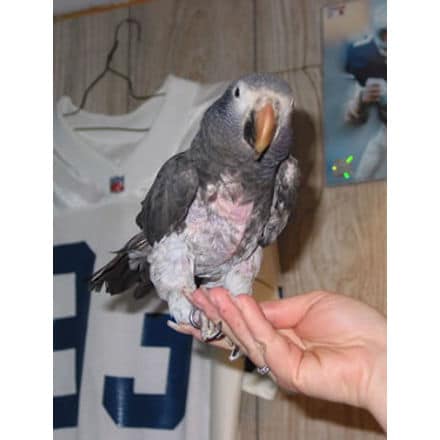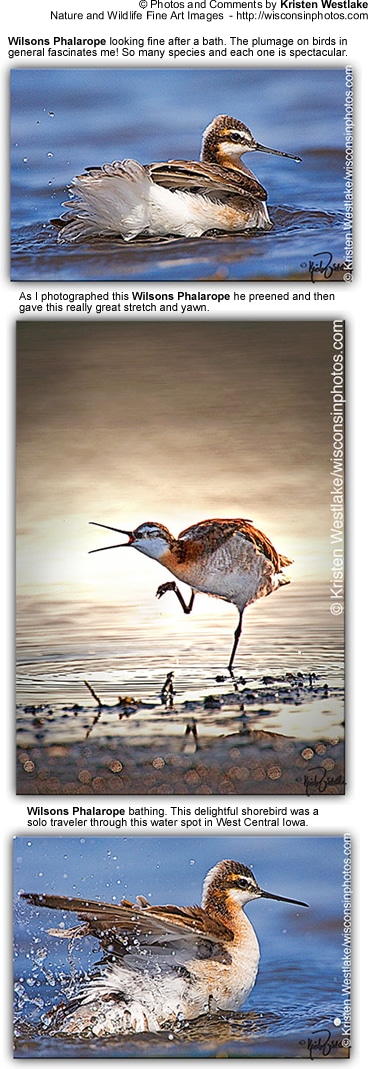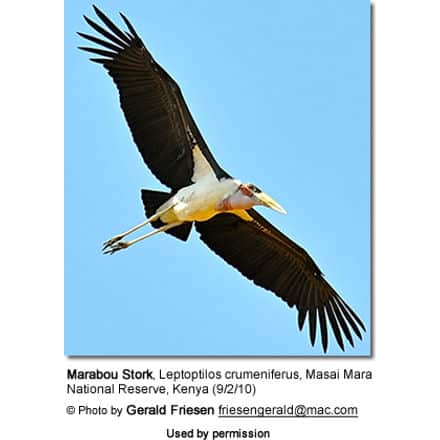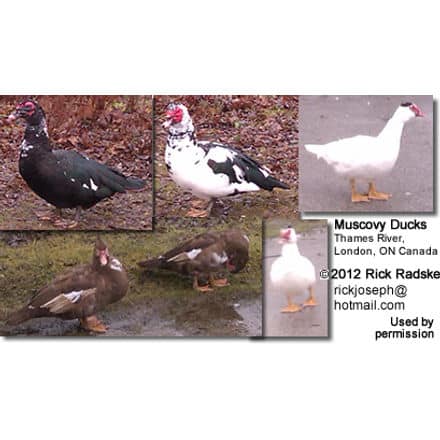Rufous-breasted or Hairy Hermit or Black Barbthroats
The Rufous-breasted Hermit, Hairy Hermit, or Black Barbthroat (Glaucis hirsutus) is a widespread and relatively common Central and South American hummingbird.
Distribution / Range
The Rufous-breasted Hermit occurs naturally from Costa Rica and Panama through Colombia and Venezuela to the Amazon Basin and into eastern Brazil. Some populations are also found on the southern Caribbean islands of Trinidad, Tobago, and Grenada.
In Brazil, it is known as balança-rabo-de-bico-torto.
Specifically, it occurs in the following countries: Brazil, Bolivia, Colombia, Costa Rica, Ecuador, French Guiana, Grenada, Guyana, Nicaragua, Panama, Peru, Suriname, Trinidad and Tobago, and Venezuela.
They typically inhabit forest undergrowth and are found along the forest edge and thickets, as well as in open habitats. They often remain near running water.
Subspecies
Glaucis hirsutus hirsutus (Gmelin, 1788) – Nominate Race
- Glaucis hirsutus insularum (Hellmayr and Seilern, 1913)
- Glaucis hirsutus affinis (Lawrence, 1858)
- Glaucis hirsutus abrawayae (proposed subspecies – usually considered invalid)

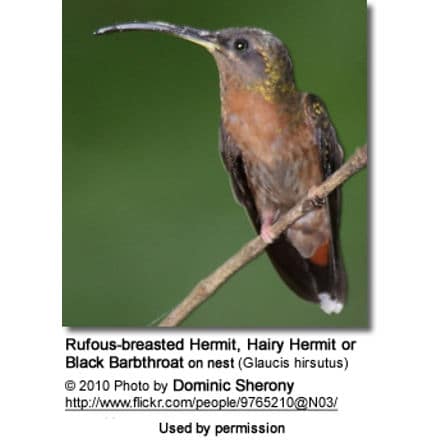
Description
The Rufous-breasted Hermit averages 10.7 cm (4.2 in) in length and weighs about 7 g (0.25 oz). Its thin and strongly down-curved beak is ~ 3.3 cm (1.3 in) long. The upper beak is dark-colored, and the lower bill is yellow.
The head is brownish. The upper plumage is dark green/brownish and the under plumage is brownish / rufous-colored.
The central tail feathers are green. The outer tail feathers are rufous-colored. The tail feathers have a broad black band near the end of the tail feathers followed by white tips.
Males and females look mostly alike; except the male has yellow streaking on his upper bill and the female’s plumage is a little duller. Her bill is also slightly shorter and has a stronger down-curve.
The immature males resemble the barbthroats (Threnetes) and were once described as a distinct species, the “Black Barbthroat” (“Threnetes grzimeki”).
Similar Species: The Hairy Hermit closely resembles the Bronzy Hermit – and these two are often considered conspecific (one single species). However, the Hairy Hermit is a little larger than the Bronzy Hermit; and even though their natural range meets in western Panama and western Colombia there have not been any signs of interbreeding.
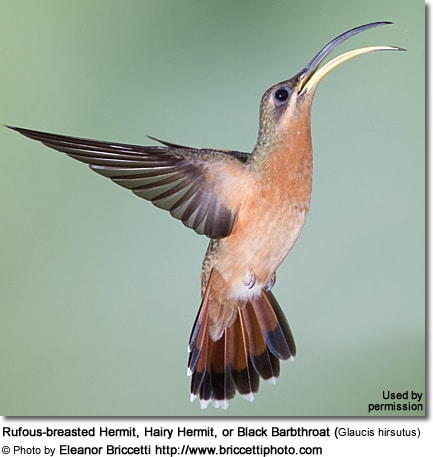

Nesting / Breeding
Hummingbirds in general are solitary and neither live nor migrate in flocks. The male Hermit’s main involvement in the reproductive process is the actual mating with the female, assisting with the building of the nest, and the protection of the young. He doesn’t incubate the eggs, nor feed the chicks.
Hairy Hermits build a remarkable cone-shaped nest that hangs by a single strong string of spiders’ silk and/or rootlets from some overhead support, which could be a branch or the underside of the broad leaves of, for example, Heliconia plants, banana trees or fern about 3 – 6 ft (1 – 2 m) above ground. However, these unusual nests have been found beneath bridges, in highway culverts and even hanging from roofs inside dark buildings. The nest is often near a stream or waterfall. It is constructed out of plant fibers woven together and green moss on the outside for camouflage in a protected location.
She lines the nest with soft plant fibers, animal hair, and feathers down, and strengthens the structure with spider webbing and other sticky material, giving it an elastic quality to allow it to stretch to double its size as the chicks grow and need more room.
The average clutch consists of two white eggs, which she incubates alone for about 17 days. The young are born blind, immobile, and without any down. The female feeds the chicks with regurgitated food (mostly insects since nectar is an insufficient source of protein for the growing chicks). The chicks leave the nest when they are about 23 days old.
She may nest up to four times in a season. In some regions (for example Colombia), this species breeds year-round.
Hummingbird Resources
- Hummingbird Information
- Hummingbird Amazing Facts
- Attracting Hummingbirds to Your Garden
- Hummingbird Species
- Feeding Hummingbirds
Diet / Feeding
The Rufous-breasted Hermit are very specific in their feeding habits. They will only feed from flowers that have the approximate length, and closely follow the curvature, of their bills. Their favorite food plants are Zingiberales (Costus scaber [Costaceae], Heliconia standleyi, Heliconia stricta [Heliconiaceae]; Gentianales (Duroia hirsuta, Palicourea lasiantha, Psychotria bahiensis and Psychotria platypoda [Rubiaceae]); Lamiales (Sanchezia peruviana [Acanthaceae]; Drymonia semicordata [Gesneriaceae]; Myrtales (Cuphea melvilla [Lythraceae]).
Hermits are “trap-line feeders”. They visit plants along a long route (in this case up to 0.6 miles or 1 km). This behavior differentiates them from most other hummingbird species which generally maintain feeding territories in areas that contain their favorite plants (those that contain flowers with high-energy nectar), and they will aggressively protect those areas.
These birds use their long, extendible, straw-like tongues to retrieve the nectar while hovering with their tails cocked upward as they are licking at the nectar up to 13 times per second. Sometimes they may be seen hanging on the flower while feeding.
Many native and cultivated plants on whose flowers these birds feed heavily rely on them for pollination. The mostly tubular-shaped flowers actually exclude most bees and butterflies from feeding on them and, subsequently, from pollinating the plants.
As the hummingbirds thrust their long bills deep into the flowers for nectar their faces are dusted in pollen, which they then carry to the stigma of a nearby similar plant.
For some plants, such as Cuphea melvilla, Psychotria bahiensis and P. platypoda, the Hairy Hermit seems to be a critically important pollinator.
They may also visit local hummingbird feeders for some sugar water, or drink out of bird baths or water fountains where they will either hover and sip water as it runs over the edge; or they will perch on the edge and drink – like all the other birds; however, they only remain still for a short moment.
They also take some small spiders and insects – important sources of protein particularly needed during the breeding season to ensure the proper development of their young. Insects are often caught in flight (hawking); snatched off leaves or branches, or taken from spider webs. A nesting female can capture up to 2,000 insects a day.
Males establish feeding territories, where they aggressively chase away other males as well as large insects – such as bumblebees and hawk moths – that want to feed in their territory. They use aerial flights and intimidating displays to defend their territories.
Calls / Vocalizations
The Hairy Hermit’s call is described as a high-pitched sweet.


